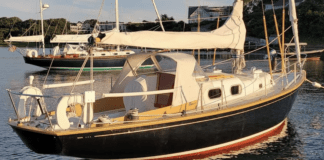
A little over a week after one of this countrys most tragic man-overboard incidents in recent U.S. sailboat-racing history, we got news that the Federal Communication Commission has approved promising new technology for man-overboard recovery. According to a press release issued today from Kannad Marine, the FCC has approved for sale in the U.S. Kannads SafeLink R10 SRS, a personal Automatic Identification System (AIS) device designed to be worn by individuals and activated to assist in man-overboard recovery.
It seems unlikely that this device would have saved lives in the Farallones Race tragedy, but its usefulness to the offshore sailor who worries about man-overboard recovery seems self evident. The new technology will be particularly handy for cruisers who venture far afield, where self-rescue is the only real option.
When we last reported on this topic, new standards for these devices had just been established. All that was preventing them from entering the market was FCC approval. That hurdle now behind us, we can look forward to them hitting the market soon.
There are other options for locating a man overboard using onboard electronics. We’ve tested many of them, and weve talked about the product before. Heres a basic description of what it does.
Worn on a life jacket and activated by simply sliding off the safety tab and lifting an arming cap to deploy the antenna, the SafeLink R10 sends structured alert messages, GPS position, and a special identity code directly to AIS receivers within an approximately four-mile radius. The position data is generated by a built-in GPS receiver that updates every 60 seconds. Using location, bearing and range data indicated on the AIS receiver displays, crew members or nearby sailors will be able to locate the man overboard, greatly increasing chance of survival.
The R10 can also be professionally fitted to a life jacket so that it automatically activates when the life jacket is inflated. A flashing LED light aids location at night. The R10 is guaranteed to transmit continuously for 24 hours and has a seven-year battery storage life. It is just less than 5 inches long and 2 inches thick, weighs 4.23 ounces, and is waterproof to 15 feet.
We will be testing this product as soon as one becomes available. One detail we are interested in is the range and reliability of transmission when the unit is attached to an inflatable life jacket.
The manufacturer’s suggested retail price in the U.S. is $349.








































